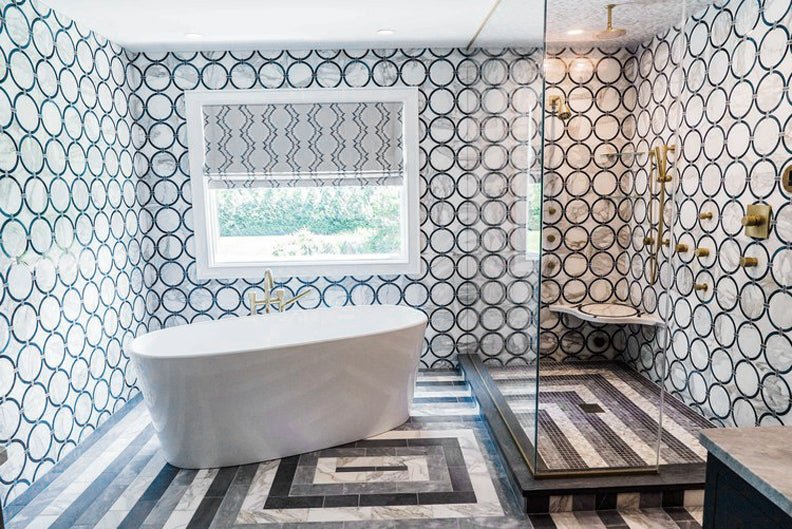Mosaic tiles come in all shapes and sizes, and they can be used in countless different ways. Before you settle on a plan for your next tile project, make sure you’re familiar with the various options available to you. As you peruse mosaic tile patterns, you may discover a new favorite that would look just right in your home.
1. Straight Joint
For a reliable mosaic tile pattern, consider arranging your geometric tiles with straight joints. That means that they’re lined up straight across and straight up and down. The corners align.
With square tiles, straight joints can produce a modern look, as you can see below. You could also use the same sort of approach with rectangular or strip-style mosaic tiles.

2. Broken Joint
One of the most popular mosaic tile patterns is the broken-joint arrangement. It staggers the tiles so that the end of one tile begins above the middle of another, similar to how bricks are laid.
In the following picture, the strip tiles are laid in a broken-joint fashion. Broken joints are commonly used for classic subway tile layouts too.

3. Basketweave
In a basketweave pattern, the tile pieces are arranged to look like strips that weave under and over one another.
The strips might be straight-edged or curved.

Basket Weave Mosaics - View Details »
4. Pinwheel
In a pinwheel pattern, rectangular tiles are grouped in sets of four and arranged around a center axis. There’s typically a square tile in the middle of each pinwheel.
The top photo here shows a classic pinwheel arrangement. The next features a variation in which there isn’t a square at the center of each pinwheel.

Pinwheel Mosaics - View Details >>
5. Herringbone
If you’d like a zigzag look, consider herringbone mosaic tile patterns. This style sets rectangular tiles in up-and-down “V” arrangements.
This kitchen uses subway-size tiles to create a herringbone pattern, but this layout can be done with longer rectangles as well.

Herringbone Tiles - View Details >>
6. Chevron
Like herringbone patterns, chevron looks also produce zigzags. A chevron arrangement uses parallelogram-shaped tiles instead of rectangular ones. The tiles are set end-to-end in an alternating up-and-down pattern.

Chevron Tiles - View Details >>
As you can see, chevron mosaics lend dynamic energy to room designs.
7. Pennyround
Small circle tiles are often known as penny tiles. Arranging such tiles in a regular pattern can be called a pennyround layout.
For an interesting example, check out how these round tiles are extremely versatile and can be used to make a wide variety of different designs.

Penny Round Tiles - View Details >>
8. Arabesque
To accomplish an arabesque mosaic tile pattern, you have to use the right type of tile. Arabesque tiles have a shape that balloons out in the middle and comes to a point at the top and the bottom.
When arranged in an offset pattern, the pieces fit neatly into place against one another. Below, each arabesque tile is surrounded by a border, but you can also place such tiles right next to each other.

Arabesque Tile - View Details >>
9. Hexagonal
Hexagon-shaped tiles have six sides, which are often equal in length.
Using a hexagonal pattern can give your room a traditional feel. As you can see here, though, that’s not always the case. You can also produce contemporary looks with tiny hexagons.

Hexagon Tiles - View Details >>
10. Star
While you don’t see triangular tiles as often as you do other shapes, they can be useful for creating interesting star patterns.
The star pattern on the floor of this bathroom gives the space a cozy feel, perhaps because the design is reminiscent of a hand-stitched quilt.

Waterjet Tiles - View Details >>
11. Curves
You can use straight-edged pieces to create rounded shapes. This is accomplished by setting each tile at a slight angle to its neighbor.
Below, you can see three examples of this: a scalloped pattern, a circular design and a curvy arrangement.

12. Images

Versatile mosaic tiles aren’t just for arranging in geometric layouts. In the hands of a skilled artisan, they can also be patterned to represent various images. Often, each design is unique.
This kitchen uses mosaic tiles to create a fruit mural. Other mosaic tile designs might show scenery, animals, flowers or even people.
Cherry Blossom - View Details >>
13. Custom
Thanks to water-jet technology, mosaic tiles can be cut to fit together in intricate designs. Precise instruments allow artisans to make curves, scrolls and other cuts with a variety of materials that would be hard to do using older technologies. Once the pieces are ready, they’ll fit closely together in complex layouts.
This kitchen wall shows just one example of the modern look that you can achieve with custom water-jet mosaics.

Medallions and Murals - View Details >>
14. Random
Not all mosaic patterns have to fit a certain mold. Sometimes, the tiles are simply laid out in random patterns. That can be a smart way to intentionally evoke a specific mood in your room.
Take this bathroom, for instance. The random pattern of the river rock tiles gives the space a natural feel that complements the stone-themed wall art.

Hand-Cut Mosaic Tiles - View Details >>
Picking Your Mosaic Tile Patterns
Perhaps you’ve landed on a timeless mosaic tile pattern for your home, or you’ve found a contemporary arrangement that suits your style. Either way, Artsaics can produce the tile pattern that’s right for you. Our artisans specialize in custom mosaics and expertly designed projects.
Now is the time to learn more about the handcrafted mosaic tile patterns that Artsaics can prepare for your home.

